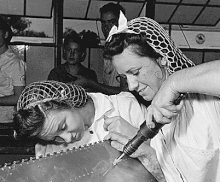

A snood (/snuːd/) is a type of traditionally female headgear designed to hold the hair in a cloth or yarn bag.[1] In the most common form, the headgear resembles a close-fitting hood worn over the back of the head. It is similar to a hairnet,[1] but snoods typically have a looser fit,[2] a much coarser mesh, and noticeably thicker yarn. A tighter-mesh band may cover the forehead or crown, then run behind the ears, and under the nape of the neck. A sack of sorts dangles from this band, covering and containing the fall of long hair gathered at the back. A snood sometimes was made of solid fabric, but more often of loosely knitted yarn or other net-like material. Historically (and in some cultures still in use today) a small bag of fine thread—netted, tatted, knitted, crocheted, or knotted (see macramé)—enclosed a bob of long hair on the back of the head or held it close to the nape.[3]
Beard snood
Another similar garment which is also referred to as a snood is used to cover facial hair such as beards and moustaches when working in environments such as food production.[4] Although it appears that "hairnet" has replaced "snood" as the common term for hair containment on the head, the term "beard snood" (essentially a "ringed scarf") is still familiar in many food production facilities.[citation needed]
Religious use
Women's snoods are often worn by married Orthodox Jewish women,[5] according to the religious requirement of hair covering (see Tzniut). Since these snoods are designed to cover the hair more than hold it,[6] they are often lined to prevent them from being see-through. Contemporary hair snoods for Jewish women come in a wide range of colors and designs.[7]
Snoods are also worn by some Christian women as a headcovering in obedience to 1 Corinthians 11:2–10.
References
- ^ a b "History of Hair Covering Part #1: Snoods". Archived from the original on 21 August 2019. Retrieved 5 January 2020.
- ^ Karen Roemuss; Martin Green; Leo Palladino (2018). Professional Hairdressing: Australian and New Zealand Edition (2nd ed.). ISBN 978-0170415927.
Snoods ... They're like a hair net but have a looser fit and much coarser mesh ...
- ^ Carmenica Diaz (2014). Tales of Aswin. ISBN 978-1291990027.
- ^ "SmartGuard Beard Snood | | Food Industry Workwear | Disposable Workwear | Protective Workwear | Personal Protective PPE". Protec Direct. Archived from the original on 2012-03-21. Retrieved 2011-09-23.
- ^ "Rabbis' Rules and Indian Wigs Stir Crisis in Orthodox Brooklyn". The New York Times. May 14, 2004.
- ^ Silver, Rivki (5 February 2012). "Me and My Covered Hair, Part Two: Tichels, Hats and More". Retrieved 5 January 2020.
- ^ "Snoods VS. Sheitels". Retrieved 5 January 2020.
External links
![]() Media related to Snoods at Wikimedia Commons
Media related to Snoods at Wikimedia Commons

